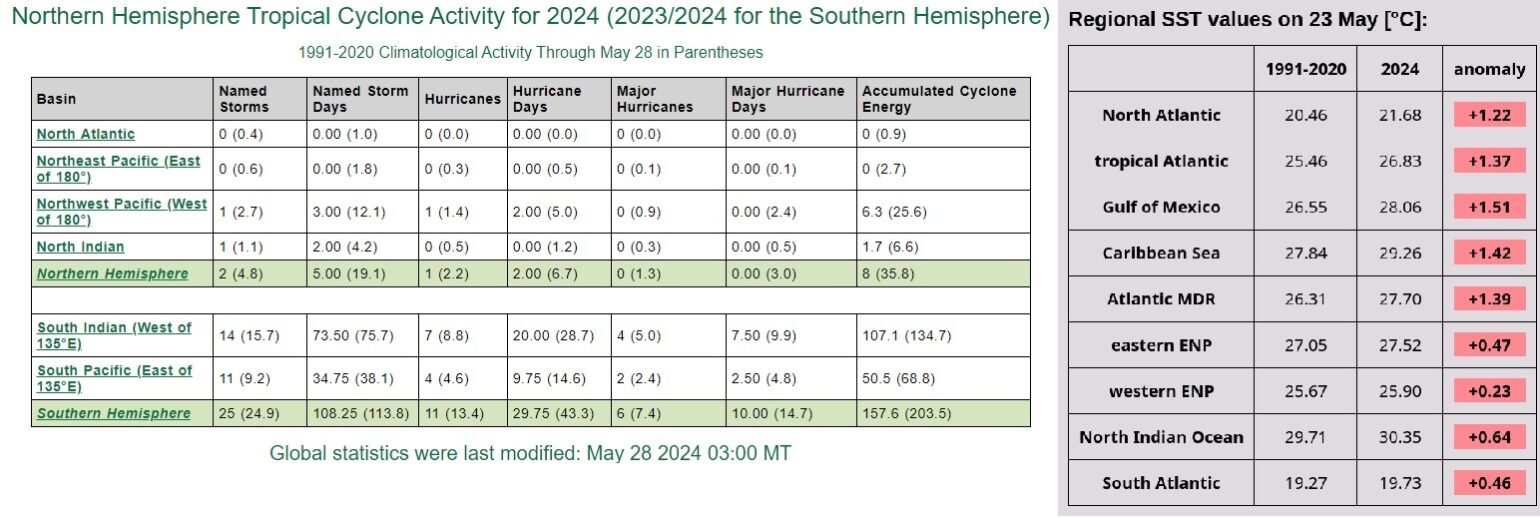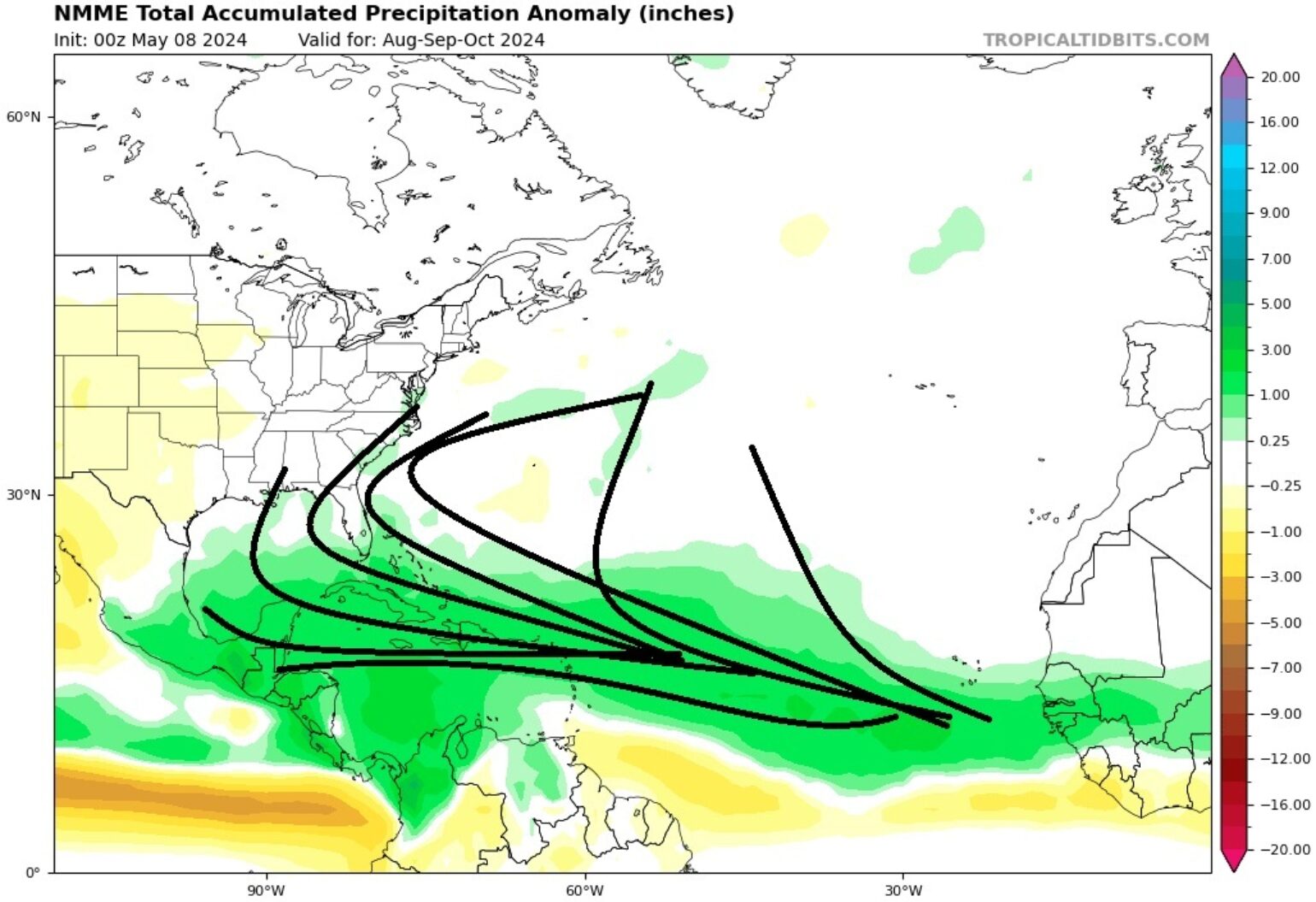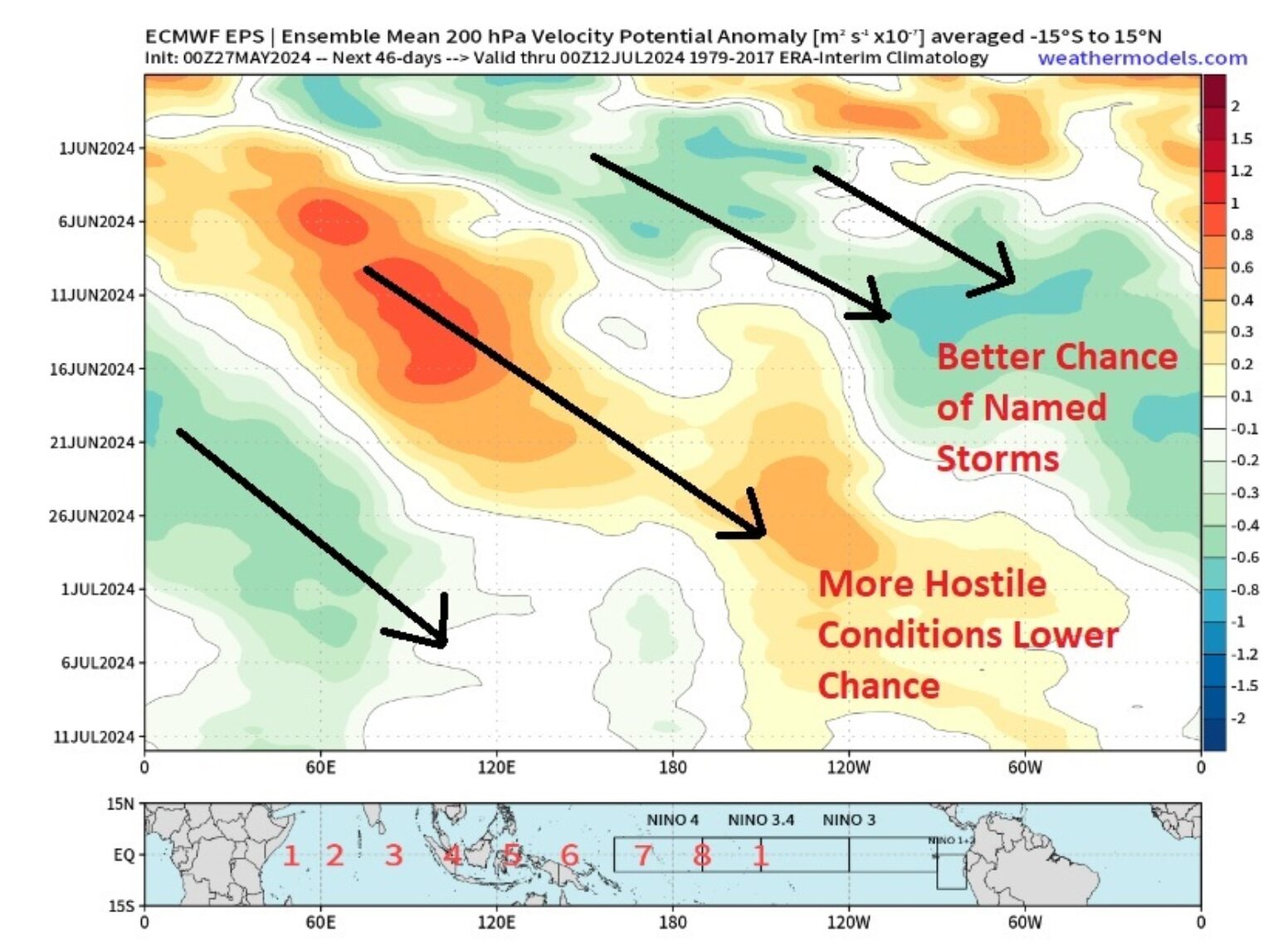The 2024 Atlantic hurricane season officially begins in four days, and it looks like this will be the first time since 2014 that we likely will not have a named storm form in the North Atlantic Ocean before June 2nd. In fact, something you might not hear in the media is that the North Hemisphere is off to a historically slow start. Just this weekend, the first named storm occurred in the Northern Hemisphere, with Typhoon Ewiniar forming in the West Pacific basin. This is particularly amazing considering one has to go back far as to the beginning of the 1970s to go this late in the Northern Hemisphere storm season to see its first name storm. What makes this even more impressive is that worldwide, sea surface temperatures are extremely warm across most ocean basins.

Currently, the tropical Atlantic is calm, with just a couple of tropical waves in the Atlantic Basin, but if you have been paying attention, you will know that there is nonstop media coverage of the various named storm forecasts from various forecasting outlets. They are all predicting an active season ahead, with some even suggesting record-named storm activity. This is because significant climate forcers are at play. As we highlighted in our last BMS Tropical Update issued on March 19th, over the past year, an El Niño event in the Pacific is transitioning to La Niña. This transition is causing a cold tongue of water to develop and spread westward out from the South American coastline in the Central Pacific Ocean. This will reduce wind shear over parts of the Atlantic Basin. Simultaneously, the tropical Atlantic is experiencing record-warm waters conducive to increased hurricane activity. Most forecasts issued this early season are quite bullish on a very active hurricane season in terms of named storm, hurricane, and major hurricane counts.
While it is generally wise to follow the consensus in forecasting, the Atlantic can be unpredictable at times. Shorter-term variability, such as dust outbreaks or upper-level troughs, could hamper development. This is something to keep in mind when interpreting the newest forecast from NOAA, which provides a range for named storms (NS), hurricanes(H), and major hurricanes (MH). The range for major hurricanes, on the low end, is 4, which is very close to the expected average of 3.2 in each season. However, the top end of NOAA's range for Major Hurricane 7 would be tied with the most on record in any season. So, even as we enter June, we do not have a good idea of just how active the season might be.
The insurance industry is closely monitoring these named storm forecasts, but what they should be focused on understanding is the likely tracks and probability of landfall of these storms. For more detailed information on the number of named storms, hurricanes, and major hurricanes, refer to the latest forecast from Barcelona Super Computing Center and our BMS March Tropical Update, which also started to build the framework as to where these storms might track this season and this BMS Tropical Update build upon.
Development Of Storms
To better understand the overall chances of landfall in a season, we first need to understand where storm development might occur because of how many storms might recurve. Climate forecast models, such as the North American Multi-Model Ensemble (NMME) and Climate Forecast System (CFS), predict that well above normal sea surface temperatures will persist through the peak hurricane months of August to October. Warm waters in the tropical Atlantic generally lead to enhanced thunderstorm activity and cyclogenesis. At the same time, cooler waters in the Pacific suggest less vertical wind shear over the Atlantic basin's main development region due to the developing La Niña conditions. In fact, this also favors storm development. With these climate forcers and more storms overall in the basin, the dice are loaded just because more storms will form in the basin, which overall increases the landfall probability.
Although the Atlantic hurricane season has yet to start, given the forecasts for a very active season, it is important to remember activity usually does not ramp up until late August. We may end up in July or even August without many Atlantic hurricanes, but it is normal not to have many storms through August. In reality, there is no strong correlation between ACE to date vs. total season ACE until September.
Those who checked out the BMS March Tropical Update post should have noted that two of the analog years, 2010 (19NS, 12H, 5MH) and 2020 (30NS, 14H, 7MH), are very active storm seasons. However, these two seasons have drastically different landfall tracks and loss scenarios for the insurance industry.

The 2020 season had plenty of storm activity; however, eight named storms tracked into the central North Atlantic Ocean above the Main Development Region and 12 named storm landfalls. In 2010, ten named storms tracked into the Central Atlantic north of the main development region, but only two named storms made landfall. Seasons that have storms develop quicker off the West Coast of Africa tend to have storms that recurve into the Central Atlantic quicker like they did in 2010. In looking at the anomalies for mean sea level pressure and 10-meter wind shading along with the current sea surface temperature, 2010 appears to be a better match than 2020 and 2005, for that matter. Still, what might matter this season is not what develops in the main development region of the Atlantic, but what type of activity occurs in the western Caribbean and Gulf of Mexico, where in 2010 and 2020, much of the landfall activity originated.
What do the Climate Models Suggest?
Overall, seasonal forecasting skills have improved over the last decade and will likely make a significant leap in the next few years as new AI-based climate models are implemented. Although most of these climate models still lack the capabilities to resolve the realistic properties of convective storm systems, they can provide hints into areas of increased precipitation processes that could be named storms.
The NMME precipitation anomaly that spans the months of August, September, and October shows above-normal precipitation anomalies for much of the tropical Atlantic and into the Western Caribbean. In fact, you can almost make out what tropical storm system storm tracks might be.

Although some of the analogs point to a season similar to that of 2010, the insurance industry knows it only takes one storm to change market perception. Given the fact a major hurricane has not made landfall north of Fran since 1996 and the last hurricane to make landfall in New England was in 1991 with hurricane Bob, it is utterly terrifying knowing a large chunk of our coastal population has never seen the damage that a hurricane can do. This should point to some possible problems in understanding how the industry catastrophe risk models might contemplate the expected damage if one occurs.
Atlantic Basin Activity to Start Mid-June
The hurricane season might kick off in mid-June, as models predict more favorable conditions for storm formation due to equatorial waves like the Madden-Julian Oscillation (MJO). An MJO pulse will traverse the Pacific over the next two weeks and should arrive in the Atlantic by the second week of June. This will likely make the environment more conducive to tropical development, with a reduction in wind shear, particularly over the Caribbean, where the water is already as warm as it should be in August.

While it is too early to provide more detail on the exact areas of formation, the forecast warrants extra attention for the insurance industry regarding the weather that may affect the tropical Atlantic in mid-to-late June. This also means we can start to get a timing as the MJO pulse typically occurs every 30-60 days, allowing for intraseasonal variability. In other words, in late July and late August or early September, there could be another uptick of activity that would enhance named storm activity over the basin with more quiet periods in between.
While the probability is low at below 20%, the first areas of development this season look like they could occur in the Western Caribbean during the first full week of June. Any system that does form could be steered north-eastward towards the Bahamas or Florida peninsula given the expected mid-lattice pattern that is forecasted.
While the season is expected to be active, the exact timing and number of storms making landfall cannot be predicted with certainty. Nevertheless, vigilance and preparedness are essential to mitigate the impact of any storms that do form.
BMS Pathlight Analytics Is Here To Help
Overall, the information provided here highlights the importance of preparedness, as a single storm can have significant impacts regardless of the overall season activity. BMS is here to support its clients with the best-in-class event response and our award-winning Geospatial iVision product that gets updated four times daily with the latest Verisk Respond products, which have highly detailed 3-second wind gust data as well as other storm attribute information including the duration of the wind gust along with other severe storm attributes such as heavy rainfall. These attributes can be run against an insured client portfolio to understand impacts and provide timely claims management to the worst impacted areas.
Our Pathlight Analytics team runs the best-in-class catastrophic risk model and does not just prove output but provides answers to the last possible scenarios given the suite of vendor losses.
Now is the time for the public to prepare for potential hurricanes; resources like ready.gov provide guidance on evacuation routes, flood risks, and storm surge information. Residents in hurricane-prone areas should create and practice their emergency plans now. Take pictures of the contents and understand what your insurance policy does and does not cover. Flood insurance is an option, and the national flood insurance program is the program of choice. It has a standard 30-day waiting period.
Lastly, remember that no news here is good news. We will provide timely updates as needed, focusing on the insurance industry, with the intent to add value the insurance industry will not find anywhere else.
